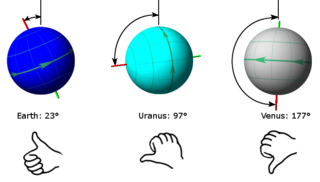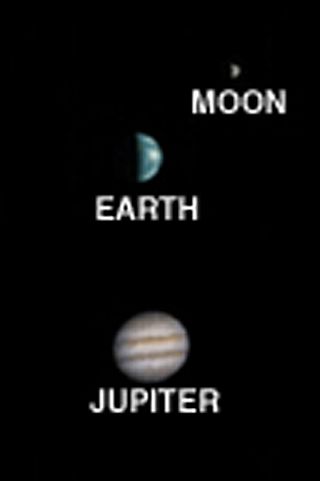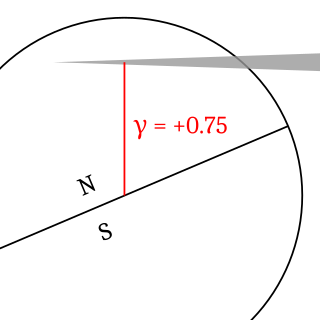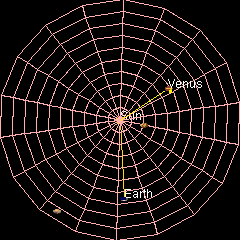
The astronomical unit is a unit of length, roughly the distance from Earth to the Sun and approximately equal to 150 billion metres or 8.3 light-minutes. The actual distance from Earth to the Sun varies by about 3% as Earth orbits the Sun, from a maximum (aphelion) to a minimum (perihelion) and back again once each year. The astronomical unit was originally conceived as the average of Earth's aphelion and perihelion; however, since 2012 it has been defined as exactly 149597870700 m.

An eclipse is an astronomical event that occurs when an astronomical object or spacecraft is temporarily obscured, by passing into the shadow of another body or by having another body pass between it and the viewer. This alignment of three celestial objects is known as a syzygy. An eclipse is the result of either an occultation or a transit. A "deep eclipse" is when a small astronomical object is behind a bigger one.

In astronomy, a conjunction occurs when two astronomical objects or spacecraft appear to be close to each other in the sky. This means they have either the same right ascension or the same ecliptic longitude, usually as observed from Earth.

Eclipses may occur repeatedly, separated by certain intervals of time: these intervals are called eclipse cycles. The series of eclipses separated by a repeat of one of these intervals is called an eclipse series.

In astronomy, axial precession is a gravity-induced, slow, and continuous change in the orientation of an astronomical body's rotational axis. In the absence of precession, the astronomical body's orbit would show axial parallelism. In particular, axial precession can refer to the gradual shift in the orientation of Earth's axis of rotation in a cycle of approximately 26,000 years. This is similar to the precession of a spinning top, with the axis tracing out a pair of cones joined at their apices. The term "precession" typically refers only to this largest part of the motion; other changes in the alignment of Earth's axis—nutation and polar motion—are much smaller in magnitude.

In astronomy, axial tilt, also known as obliquity, is the angle between an object's rotational axis and its orbital axis, which is the line perpendicular to its orbital plane; equivalently, it is the angle between its equatorial plane and orbital plane. It differs from orbital inclination.

Solar time is a calculation of the passage of time based on the position of the Sun in the sky. The fundamental unit of solar time is the day, based on the synodic rotation period. Traditionally, there are three types of time reckoning based on astronomical observations: apparent solar time and mean solar time, and sidereal time, which is based on the apparent motions of stars other than the Sun.

In astronomy, a transit is the passage of a celestial body directly between a larger body and the observer. As viewed from a particular vantage point, the transiting body appears to move across the face of the larger body, covering a small portion of it.

A transit of Mercury across the Sun as seen from Mars takes place when the planet Mercury passes directly between the Sun and Mars, obscuring a small part of the Sun's disc for an observer on Mars. During a transit, Mercury can be seen from Mars as a small black disc moving across the face of the Sun.

A transit of Deimos across the Sun as seen from Mars occurs when Deimos passes directly between the Sun and a point on the surface of Mars, obscuring a small part of the Sun's disc for an observer on Mars. During a transit, Deimos can be seen from Mars as a small dark spot rapidly moving across the Sun's face.

A transit of Phobos across the Sun as seen from Mars takes place when Phobos passes directly between the Sun and a point on the surface of Mars, obscuring a large part of the Sun's disc for an observer on Mars. During a transit, Phobos can be seen from Mars as a large black disc rapidly moving across the face of the Sun. At the same time, the shadow (antumbra) of Phobos moves across the Martian surface.

The instantaneous Earth–Moon distance, or distance to the Moon, is the distance from the center of Earth to the center of the Moon. Lunar distance, or Earth–Moon characteristic distance, is a unit of measure in astronomy. More technically, it is the semi-major axis of the geocentric lunar orbit. The lunar distance is on average approximately 385,000 km (239,000 mi), or 1.28 light-seconds; this is roughly 30 times Earth's diameter or 9.5 times Earth's circumference. Around 389 lunar distances make up an AU astronomical unit.

Many astronomical phenomena viewed from the planet Mars are the same as or similar to those seen from Earth; but some are quite different. For example, because the atmosphere of Mars does not contain an ozone layer, it is also possible to make UV observations from the surface of Mars.

A solar eclipse occurs when the Moon passes between Earth and the Sun, thereby obscuring the view of the Sun from a small part of the Earth, totally or partially. Such an alignment occurs approximately every six months, during the eclipse season in its new moon phase, when the Moon's orbital plane is closest to the plane of the Earth's orbit. In a total eclipse, the disk of the Sun is fully obscured by the Moon. In partial and annular eclipses, only part of the Sun is obscured. Unlike a lunar eclipse, which may be viewed from anywhere on the night side of Earth, a solar eclipse can only be viewed from a relatively small area of the world. As such, although total solar eclipses occur somewhere on Earth every 18 months on average, they recur at any given place only once every 360 to 410 years.

In celestial mechanics, apsidal precession is the precession of the line connecting the apsides of an astronomical body's orbit. The apsides are the orbital points farthest (apoapsis) and closest (periapsis) from its primary body. The apsidal precession is the first time derivative of the argument of periapsis, one of the six main orbital elements of an orbit. Apsidal precession is considered positive when the orbit's axis rotates in the same direction as the orbital motion. An apsidal period is the time interval required for an orbit to precess through 360°, which takes Earth's orbit about 112,000 years, completing a cycle and returning to the same orientation.

Gamma of an eclipse describes how centrally the shadow of the Moon or Earth strikes the other body. This distance, measured at the moment when the axis of the shadow cone passes closest to the center of the Earth or Moon, is stated as a fraction of the equatorial radius of the Earth or Moon.

The solar eclipse of October 25, 2022, was a partial solar eclipse visible from Europe, the Urals and Western Siberia, Central Asia, Western Asia, South Asia and from the north-east of Africa. The maximal phase of the partial eclipse occurred on the West Siberian Plain in Russia near Nizhnevartovsk, where more than 82% of the Sun was eclipsed by the Moon. In India, the Sun was eclipsed during sunset ranging from 58% in the north and around 2% in the south. From Western Europe it appeared to be around 15-30% eclipsed. It was visible between 08:58 UTC, the greatest point of eclipse occurred at 11:00 UTC and it ended at 13:02 UTC.

The history of Mars observation is about the recorded history of observation of the planet Mars. Some of the early records of Mars' observation date back to the era of the ancient Egyptian astronomers in the 2nd millennium BCE. Chinese records about the motions of Mars appeared before the founding of the Zhou dynasty. Detailed observations of the position of Mars were made by Babylonian astronomers who developed arithmetic techniques to predict the future position of the planet. The ancient Greek philosophers and Hellenistic astronomers developed a geocentric model to explain the planet's motions. Measurements of Mars' angular diameter can be found in ancient Greek and Indian texts. In the 16th century, Nicolaus Copernicus proposed a heliocentric model for the Solar System in which the planets follow circular orbits about the Sun. This was revised by Johannes Kepler, yielding an elliptic orbit for Mars that more accurately fitted the observational data.

Mars has an orbit with a semimajor axis of 1.524 astronomical units, and an eccentricity of 0.0934. The planet orbits the Sun in 687 days and travels 9.55 AU in doing so, making the average orbital speed 24 km/s.

Venus has an orbit with a semi-major axis of 0.723 au, and an eccentricity of 0.007. The low eccentricity and comparatively small size of its orbit give Venus the least range in distance between perihelion and aphelion of the planets: 1.46 million km. The planet orbits the Sun once every 225 days and travels 4.54 au in doing so, giving an average orbital speed of 35 km/s (78,000 mph).





















